building an insect factory.
Ten years ago, a pair of Red-shouldered Hawks built a nest in a tall white pine at the southern edge of Hildacy Preserve, Natural Lands’ Media headquarters. Under the watchful, binoculars-aided eyes of Preserve Manager Mike Coll, the raptors successfully fledged young. Every year since, those same adult hawks have mated, nested, and reared young at this 55-acre oasis of nature in the midst of black-topped Delaware County.
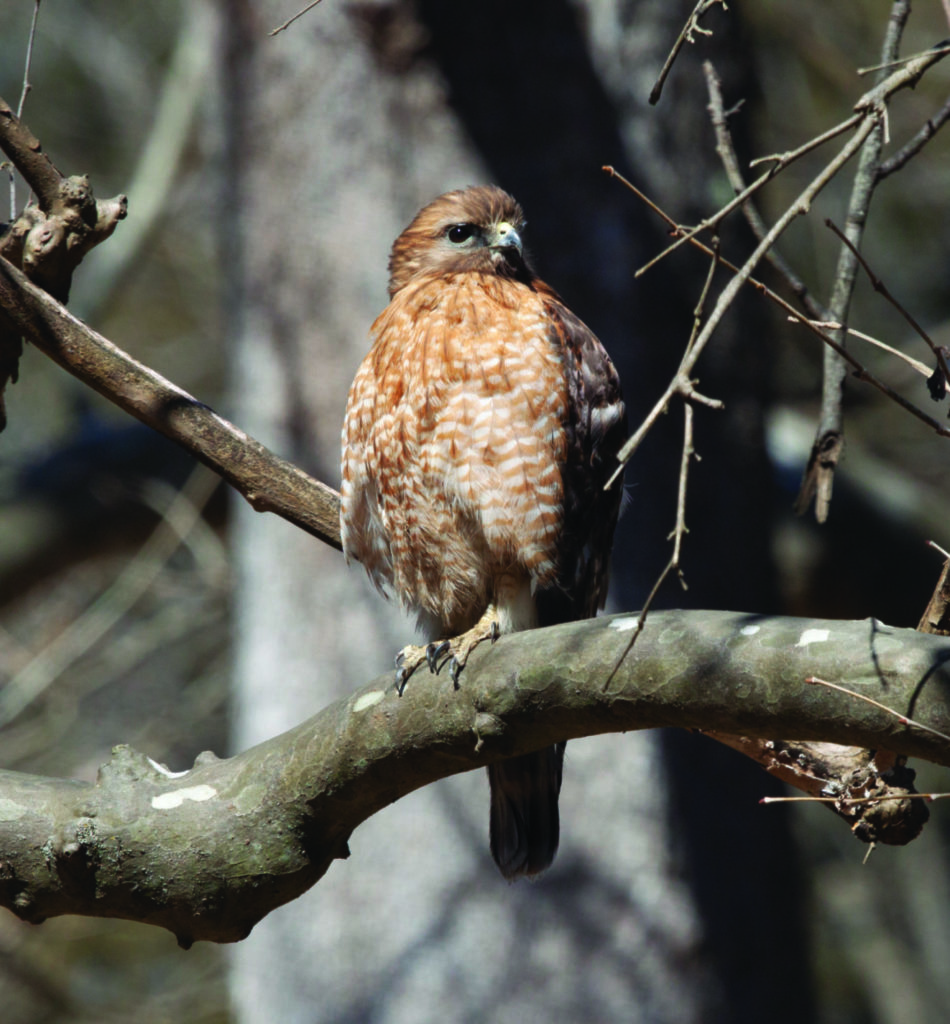
Red-tailed Hawk
photo: Mike Coll
Why?
“It’s because we’ve turned Hildacy into a giant insect factory,” says Mike. “By intentionally planting a diversity of native trees, shrubs, grasses, and perennial flowers, we are giving insects the food sources they need. The vast majority of birds feed insects to their young. And even when they aren’t eating bugs, they are eating things that eat bugs, like mice, squirrels, frogs—all of which are prey species for raptors like Red-shouldered Hawks.”
And hawks aren’t the only species thriving at Hildacy. As you will read, the particular approach that we take to caring for nature at this and all of our preserves—cultivating native ecosystems—creates the right environment for critters of all types to flourish.
Ecosystems in this region have been heavily degraded by development. As a result, this land doesn’t take care of itself. It’s not enough to just preserve land from development; we must steward it carefully—encouraging native plant species, controlling invasives, managing wildlife populations, and finding the balance between nature’s needs and visitor impacts. Do all that well, and the insects will come, along with the countless other species that exist because of them.
know your natives.
For many years, scientists and land stewards have known that native plant species are key to ecosystem restoration. This is easy to understand if we explore the food web.
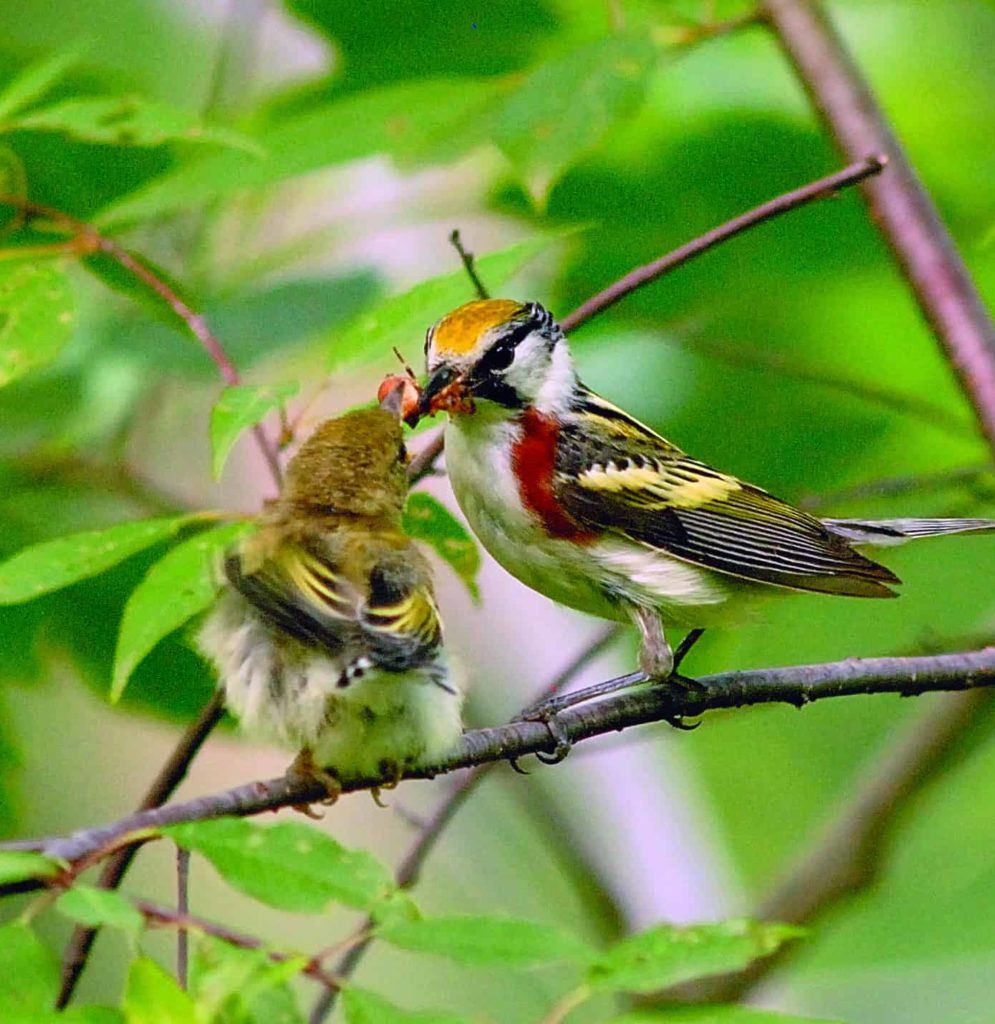
Chestnut-sided Warbler
photo: Bill Moses
Plants capture energy from the sun and turn it into food. Insects eat plants. Animals eat plants and also insects. Bigger animals eat smaller animals.
But insects are picky when it comes to their greens. They’ll only eat those species that have evolved alongside them. What’s more, about 90 percent of herbivorous insects are considered “specialists,” meaning they will eat only select plant lineages.
A well-known example of this is the beloved monarch butterfly. In their larval state, monarchs have a voracious appetite. They’ll consume 200 times their initial “birthweight” in the 10 to 14 days it takes for them to metamorphose into pupae. They only plant they’ll eat is from the genus Asclepias, commonly known as milkweed.
Caterpillars are the best creatures on the planet at converting plant energy, which is why so many birds—96 percent of North American land birds, in fact—prefer them to other types of insects. Well, that and their soft, juicy insides, which are ideal for baby birds.
Dr. Doug Tallamy, professor of entomology and wildlife ecology at the University of Delaware, and a Natural Lands Board member, uses chickadees to illustrate this preference for caterpillars. Using his own native-plant-laden property as a research site, he studied breeding chickadees by setting up cameras at their nest boxes. He determined that a pair of chickadees must access 6,000 to 9,000 caterpillars to rear one clutch of young. Caterpillars are soft, easily swallowed, and packed with protein—the perfect food for hungry chicks.
“We all have chickadees at our feeders so we think they eat seeds. And they do eat seeds, all winter long,” Tallamy said during one of the many presentations he gives across the country. “But when they are making babies, they don’t eat seeds, they eat caterpillars, and feed caterpillars to their young. And that means that if you don’t have enough caterpillars in your yard, you’re certainly not going to have chickadees.”
And you won’t have enough caterpillars if you don’t have the right plants.
powerhouse plants.
Dr. Tallamy is the lead author of a new study published in Nature that systematically identifies the most critical plants needed to sustain food webs across the United States. His research finds that only a few “powerhouse” plants support the majority of Lepidoptera, the order of insects that includes butterflies and moths. Ninety percent of what caterpillars eat is created by just 14 percent of native plant species, with a mere five percent of plants producing 75 percent of the food.
Native oaks, willows, birches, and wild cherry trees are on Tallamy’s powerhouse list, along with goldenrod, asters, and perennial sunflowers.
At Hildacy Preserve, Mike Coll has been adding these species along with many other natives to the 55-acre preserve. On this property alone more than 1,500 native trees have been planted in the last decade, along with hundreds of native shrub species. Many acres of meadows have been converted to native grasses. Even the wetland areas have been planted with native species of plants that thrive in anerobic soil conditions.
making space.
Of course, planting native species isn’t the whole equation. Invasive plants—species introduced from other parts of the world that lack natural predators and grow unchecked—are all too adept at crowding out their native cousins. Looking at the thick carpet of English ivy and pachysandra growing in a patch of woods not far from the Hildacy headquarters building, Mike acknowledges the challenge.
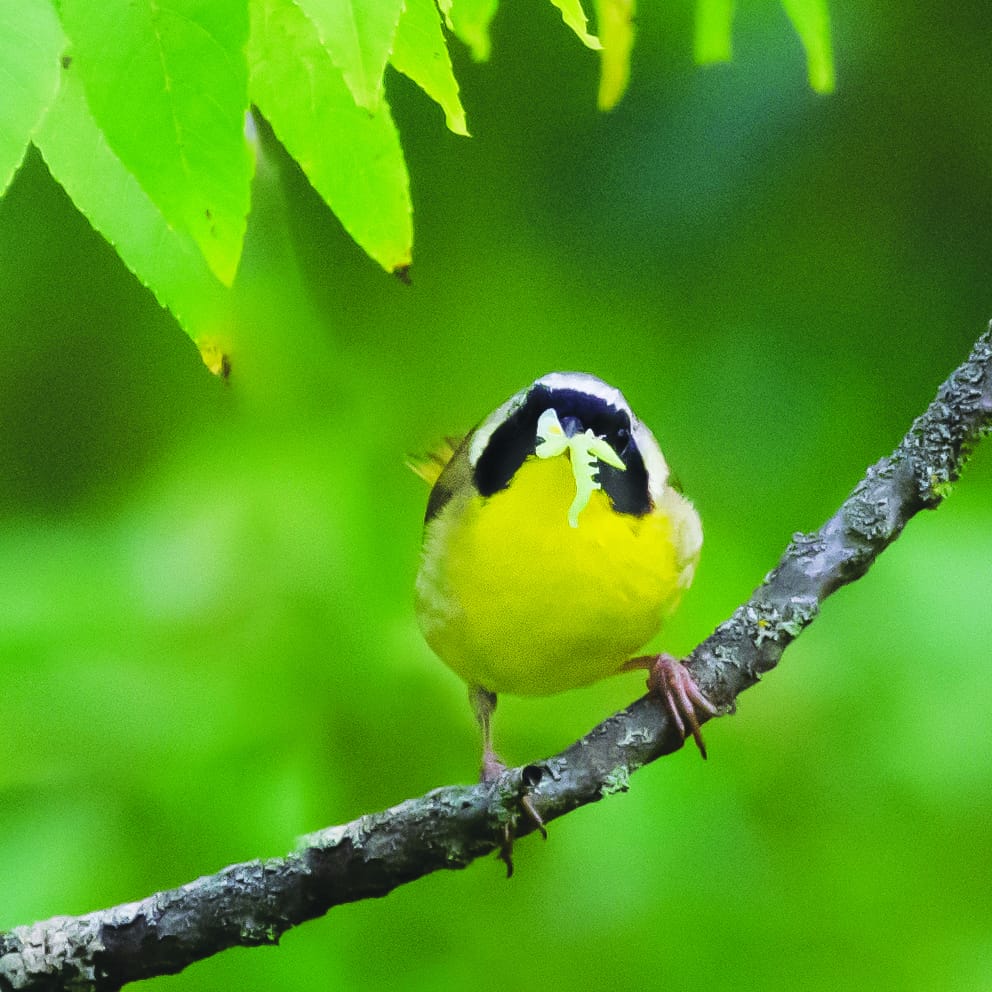
Magnolia Warbler
Photo: Randy Richard
“Eradicating all non-native plants isn’t a reasonable goal for preserves in this region; there are just too many and they are too successful. Instead, we try to control them, generally focusing on areas that are less degraded first.” He adds, “It’s a constant, never-ending project.”
And a time-consuming one. All of Natural Lands’ preserve managers are responsible for the stewardship of several nature preserves. Without the help of volunteers willing to pitch in to remove invasive plants, these weedy thugs would spread faster than we could manage them.
Planting natives can actually help our efforts to control invasives. By creating an incredibly dense tapestry where every possible space is occupied by myriad native plants, there are far fewer places for weeds to take hold and grow.
In 2018, Mike installed a meadow around the main office building at Hildacy Preserve. He used a mix of native grasses and perennial herbaceous plants, and over-seeded them to create a thick carpet. The native plants provide food for caterpillars and other insects, nectar sources for butterflies and hummingbirds, and seeds for short-tailed shrew and meadow jumping mouse among others.
“It’s taken a couple years to get established,” Mike said. “But the tall grasses and pollinator-friendly flowers offer far more ecological benefits than the turf that existed there previously.” He mows the meadow annually and spot-treats with herbicide to deter plants like Japanese honeysuckle and mile-a-minute weed.
lawn as wasteland.
The meadow around the headquarters building replaced several acres of lawn. Now, instead of what was essentially an ecological wasteland, there is habitat for insects, small mammals, birds, and so on along the food web.
A 2018 study by the National Science Foundation (NSF) of residential lawns confirmed what ecologists have known for years. The NSF researchers found that America’s love affair with turf is contributing to a continental-scale ecological homogenization. Add to that the amount of fossil fuels needed to keep those lawns neat and tidy, and the gallons of water needed to keep them green, and it’s easy to see why environmentalists advocate reducing turfgrass whenever possible.
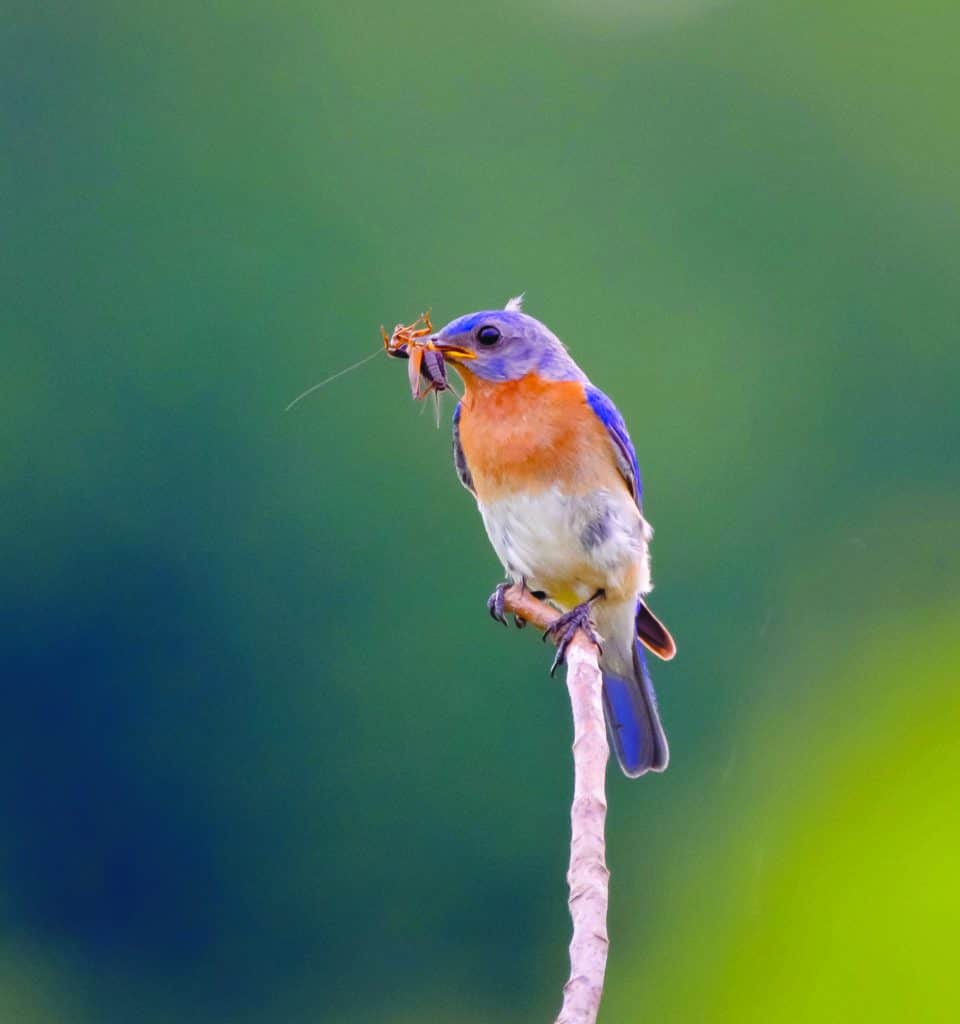
Eastern Bluebird
Photo: Greg Grimshaw
At Hildacy, Mike knew swapping meadow for lawn would have a positive impact on the overall ecology of the preserve. And he hoped he’d see even more raptors to join the resident Red-shouldered Hawks.
One species in particular that he was rooting for was the Eastern Screech Owl.
Many years back, Mike installed a nest box not far from his cottage on the preserve. For the first three years, a male roosted in the box. Each spring, he called from the entrance of the box, but was unsuccessful at attracting a mate. The fourth year his luck changed with the arrival of a female Screech Owl, and though the pair produced a clutch of eggs, none of them hatched. The following year had the same disappointing result.
Finally, in 2020, the nesting pair successfully reared and fledged three owlets. While Mike can’t be sure the conversion from lawn to meadow made the difference, creating more space for owl prey to thrive certainly didn’t hurt!
“Owls eat a mouse or other rodent-sized meal every single night. The female will tear the catch into bite-sized pieces for her babies,” Mike said. “Having enough food readily available to minimize energy expenditure helps tips the scales in favor of successful breeding.”
Eastern Screech Owls generally breed within two miles of the place they were born, which means Hildacy may become home to generations of these petite predators. If so, Mike will have his binoculars at the ready to watch their progress.
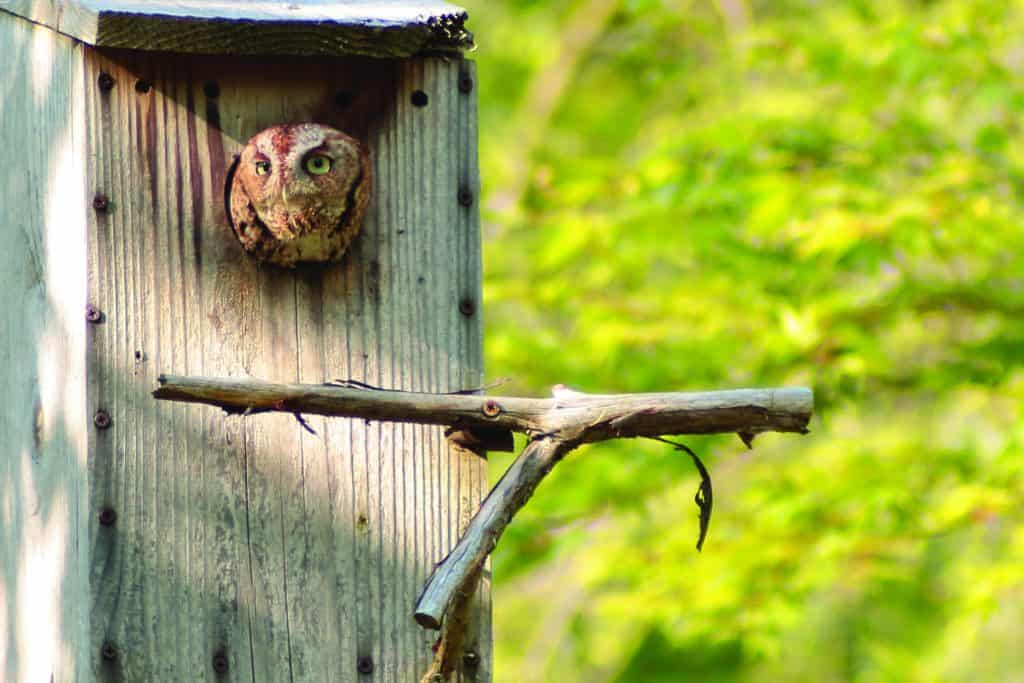
Eastern Screech Owl
photo: Mike Coll
